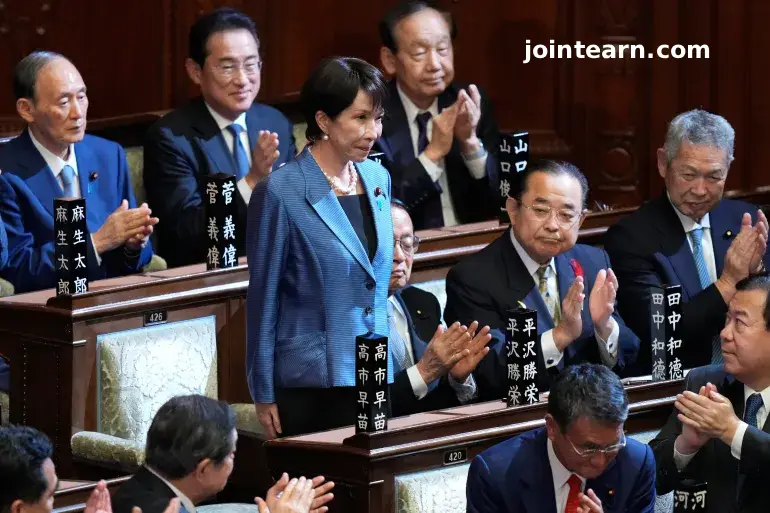
Tokyo, Japan — October 21, 2025.
Japan has reached a historic milestone as lawmakers officially confirmed Sanae Takaichi as the nation’s first female prime minister, marking a new chapter in the country’s post-war political history. The long-time Liberal Democratic Party (LDP) stalwart and protégé of the late Shinzo Abe secured 237 votes in the 465-seat lower house of parliament, clinching her position after a tense leadership struggle and last-minute coalition negotiations.
A Political First: Breaking Barriers in Japan’s Male-Dominated Politics
Takaichi’s appointment represents a groundbreaking moment in Japan’s political landscape, where women remain vastly underrepresented in positions of power. Her rise to the premiership comes amid growing public demand for stronger leadership following months of political uncertainty.
The appointment, finalized after the LDP struck a late coalition deal with the right-wing Japan Innovation Party (JIP) — also known as Ishin — narrowly avoided a continued leadership void. Despite this agreement, the new government remains two seats short of a parliamentary majority, creating a fragile start for the country’s first female leader.
End of a Political Vacuum and the Start of a New Era
Takaichi succeeds Shigeru Ishiba, whose short tenure ended in turmoil following the LDP’s disastrous performance in the July 2025 general election. That defeat left Japan without clear leadership for nearly three months, delaying key domestic and international policy decisions.
Her election is seen as a stabilizing move within the LDP ranks, yet political analysts warn that the lack of a majority may fuel instability and potential gridlock. The LDP’s previous coalition partner, the centrist Komeito Party, withdrew earlier this year over concerns about corruption and the LDP’s growing nationalist agenda.
Takaichi’s Ideology: Conservative and Nationalist Roots
Sanae Takaichi, often described as a hardline conservative, is known for her unwavering loyalty to Abe’s vision of a “strong Japan.” Her political stance is characterized by traditional values, fiscal stimulus policies, and an assertive defense strategy.
She has consistently opposed same-sex marriage, the use of separate surnames for married couples, and any change to the imperial family’s male-only succession rule. These positions have drawn criticism from advocates of gender equality, who argue that her leadership, while symbolically historic, may not advance women’s rights or social diversity.
“Takaichi’s win is both a historic and paradoxical moment,” said Tokyo University political analyst Haruto Saito. “While Japan now has its first female prime minister, her ideology does not necessarily align with progressive reform.”
Coalition Fragility and Calls for Stability
During the coalition signing ceremony with JIP leader and Osaka Governor Hirofumi Yoshimura, Takaichi emphasized the need for unity.
“Political stability is essential right now,” she declared. “Without stability, we cannot implement policies for a stronger economy or effective diplomacy.”
JIP, however, has stated it will withhold ministerial participation until it can fully trust the LDP’s reform commitments. This conditional alliance leaves Takaichi’s Cabinet vulnerable as it begins governing amid economic strain and public skepticism.
Economic Challenges: Inflation, Debt, and the “Takaichi Trade”
After decades of battling deflation, Japan is now contending with rising prices that have frustrated consumers and fueled opposition movements. Takaichi, following in Abe’s footsteps, is expected to maintain a pro-stimulus, high-spending economic approach aimed at revitalizing growth.
This strategy has sparked the so-called “Takaichi Trade” in the Tokyo Stock Exchange, with investors betting on expanded fiscal spending. The Nikkei 225 index surged to record highs following her confirmation. However, financial experts remain concerned about Japan’s massive debt load, which already surpasses 250% of GDP — the highest among developed nations.
Diplomatic Priorities and Upcoming Challenges
Takaichi’s schedule is packed from the outset. She is set to deliver a major policy speech later this week outlining her economic and security goals. Upcoming engagements include talks with U.S. President Donald Trump and participation in several regional summits focused on trade, defense, and energy cooperation.
Her administration is also expected to revisit debates around constitutional reform, military readiness, and Japan’s role in regional security alliances, signaling a continuation of Abe’s hawkish foreign policy stance.
A Historic Yet Uncertain Future for Japan
Sanae Takaichi’s ascension as Japan’s 104th prime minister is undeniably historic — a symbolic breakthrough in a nation where women account for less than 10% of parliament. Yet the true measure of her leadership will depend on her ability to navigate deep political divisions, economic challenges, and a skeptical public.
Her government faces an uphill battle to maintain legitimacy, build consensus, and demonstrate that her leadership can bring more than just symbolism. Whether Takaichi’s rise marks a transformative era or a continuation of Japan’s conservative tradition remains to be seen.
Leave a Reply